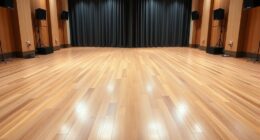Texture as a musical element refers to how sounds and layers are combined within a piece, shaping its emotional feel. It can be thick and complex, creating a sense of richness, or sparse and transparent for clarity and calmness. Playing with contrast—like shifting from dense to light sections—guides your emotional response and highlights key moments. Exploring these textures reveals how composers craft deep expressive stories, and if you keep exploring, you’ll uncover even more about how texture influences your listening experience.
Key Takeaways
- Musical texture refers to how different musical lines and sounds are layered or sparse within a piece.
- It influences the emotional mood, creating feelings of chaos, serenity, intimacy, or clarity.
- Variations in texture, such as contrast between dense and transparent sections, guide listener focus and emotional response.
- Texture enhances musical complexity, making compositions more immersive and engaging.
- Understanding musical texture deepens appreciation for arrangement choices and artistic expression.

Have you ever noticed how music can feel thick and layered or light and transparent? That sensation is largely shaped by the texture of the sound—how different musical elements combine to create a specific listening experience. Texture in music isn’t just background noise; it’s a fundamental element that carries emotional weight and adds depth to what you hear. When a piece has layered complexity, multiple musical lines weave together, each with its own role, creating a rich tapestry of sound. This complexity invites you to listen more closely, discovering new details each time you engage with the music. Conversely, a transparent, sparse texture strips away unnecessary layers, highlighting individual notes or motifs, making the music feel more immediate and direct. This contrast in textural elements can evoke different feelings, from the chaos of dense arrangements to the serenity of minimalism.
One of the most compelling aspects of musical texture is how it uses textural contrast to shape your emotional response. When a composer or performer shifts from a thick, layered section to a simpler, more transparent one, it acts like a sonic spotlight, drawing your attention to specific moments or themes. For example, a lush orchestral swell might give way to a solo instrument playing alone, emphasizing intimacy or vulnerability. These contrasts aren’t accidental; they’re deliberate choices that guide your emotional journey through the music. The layered complexity can create a sense of tension or excitement, as multiple voices or instruments interact, each adding a different flavor to the overall sound. Then, when the texture thins out, it provides relief or clarity, allowing you to focus on a particular melody or lyric without distraction. Recognizing these deliberate choices can enhance your appreciation for the artistry behind the music.
Understanding how texture works helps you become a more attentive listener. Notice how different arrangements affect your mood. A thick, textured piece might feel overwhelming but immersive, pulling you into a world of intricate soundscapes. A sparse, transparent texture might feel calming and spacious, giving each note room to breathe. Artists use these textural choices to craft their message and evoke specific responses. Whether it’s the dense layers of a jazz ensemble or the minimalism of a solo piano piece, texture influences how you connect with the music. By paying attention to layered complexity and textural contrast, you deepen your appreciation for the craft behind the sound and enhance your emotional engagement with each piece you hear. Embracing the idea that musical texture can carry emotional weight opens new avenues for experiencing and interpreting music more profoundly.
Frequently Asked Questions
How Does Texture Influence Emotional Expression in Music?
You feel emotion in music through texture, as harmony interplay and timbral layering shape its mood. When the harmony is thick and complex, it creates tension or excitement, while sparse textures evoke calm or introspection. By blending different instrument sounds and layers, you experience depth and nuance, making the music more expressive. Texture guides your emotional response by emphasizing certain feelings through its richness or simplicity.
Can Texture Be Combined With Other Musical Elements for New Effects?
Yes, you can combine texture with other musical elements to create new effects through layering techniques. By layering different textures, you add sonic complexity that enhances the emotional depth or intensity of your music. For example, combining thick, dense textures with sparse, delicate ones can build tension or release. Experimenting with these techniques allows you to craft rich, dynamic soundscapes that evoke unique emotional responses and keep your listeners engaged.
How Do Composers Intentionally Manipulate Texture?
You can intentionally manipulate texture by using layering techniques, adding or removing layers of sound to create desired effects. For example, increasing orchestral density can make music sound fuller and more intense, while thinning textures can evoke intimacy. Composers carefully choose which instruments to emphasize or silence, adjusting the interplay and density of sounds to shape the emotional and dynamic character of the piece.
What Is the Role of Texture in Different Musical Genres?
You’ll notice that in genres like classical or jazz, texture varies to create different emotional effects. For example, polyphonic layering adds complexity and richness, while homophonic clarity emphasizes melody and harmony. In pop music, clear textures help listeners focus on vocals, whereas in ambient genres, layered textures evoke atmosphere. Understanding these roles allows you to appreciate how composers use texture to shape your listening experience across various musical styles.
How Does Texture Affect Listener Engagement and Perception?
Texture considerably influences your engagement and perception by creating layered harmonies and rhythmic complexity that captivate your attention. When music features rich, intricate layers, you’re more likely to stay engaged, discovering new details with each listen. Conversely, simpler textures may evoke a relaxed or focused feeling. Your emotional response depends on how these elements combine, making texture a powerful tool to shape your overall musical experience.
Conclusion
You now see how texture weaves through music like a tapestry, each thread representing layers of sound that shape the entire piece. Just as a fabric’s richness depends on its weave, a composition’s depth relies on its textures. Remember, in music, texture is the silent hand that guides your emotional journey—like an unseen river shaping the landscape. Embrace this element, and let it transform your listening into a vivid, living landscape.










